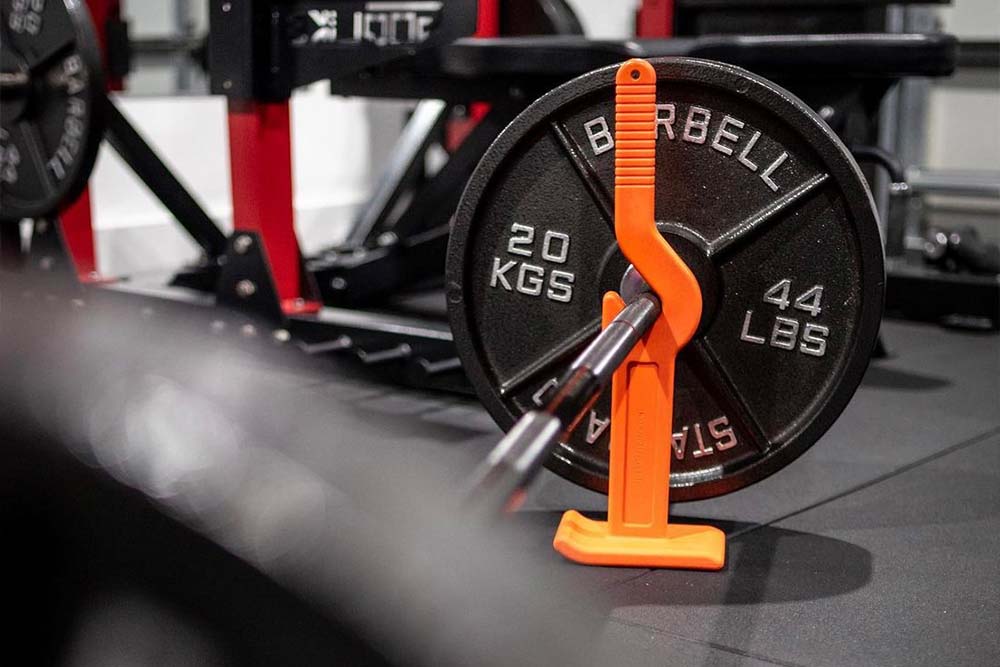Sandbags make an incredibly dynamic and versatile addition to a home gym and can provide a new way to challenge traditional exercises like squats, pushing and pulling. Sandbags are shapeshifting implements that’ll challenge the core and stabilizer muscles to a greater degree, and allow for unique opportunities to train a variety of rotational, throwing and carrying drills/
In this article, we’ll cover the benefits of training with sandbags, exercises and ideas for use.
The benefits of using sandbags
Sandbags are incredibly versatile pieces of equipment and probably one of the most overlooked gym tools a person can incorporate into a workout regimen.
The benefits of sandbag training include:
- Improve stabilizer muscles and core strength
- Functional strength training
- Build strength
- Encourages movement patterns and multi-planar
- Unique multi-planar movements
- Great for floors that cannot tolerate iron-based fitness equipment (barbells, etc.)
- Affordable, space-friendly, good for road workouts
Functional training was a paradigm shift in the fitness industry and a departure away from traditional bodybuilding and isolation-style workout routines. The goal of functional exercises was/is to maximize the carryover from gym work to athletic performance and the demands of daily life. Functional training is practical and useful versus being attractive.
Sandbag training is one of the most functional pieces of fitness equipment because it conditions the core, stabilizer muscles, and grip, unlike most ergonomic gym tools. The shape-shifting characteristics trigger core engagement and mimic the tasks we're often confronted with completing daily. A sandbag’s texture makes it difficult to hold, and while that might sound like a negative, it’s one of the best features of sandbag-loaded exercise. Every repetition is a fight.
The sandbag has instability built into it. The reason stabilizing muscles get blasted during sandbag exercises is simple: uneven, constantly shifting weight. Each rep is less predictable. Pressing a rigid object like a barbell is very predictable. Each repetition with a sandbag can and probably will be slightly different from the previous repetition or the next repetition. This unpredictability means you must stay focused to maintain body tension to control the weight.
Overstuffing a sandbag with inner fill bags is excellent for increasing the weight (more on progressive overload further down) but bad for creating instability. The filler bags must have room to move around inside of the outer shell if you want to maximize the instability component.
Having a few different sandbag sizes gives you the most options to load up and train for strength or go lighter and work explosive or rotational exercises.
Sandbag training and natural movement patterns
Movement patterns are the foundation of movement for the human body. For fitness, movement patterns help categorize various exercises based on their mechanical demands.
Here are a few of the most recognizable movement patterns:
- Squat
- Lunge
- Hip Hinge
- Push
- Pull
- Core
- Carrying
Pushing describes upper body movements, such as overhead and bench pressing. Pulling represents rows, chin-ups, and pull-ups.
Movement patterns should be learned and perfected using just bodyweight first. Since the body quickly adapts to stress, increasing the challenge by adding load with a sandbag is a good idea. Adding load will challenge the muscles and lead to progressive gains.
Beyond the functional carryover to everyday living, movement patterns are also effective for building muscle since most of these exercises work a large amount of musculature. It only takes a few grinding reps of bearhug sandbag squats, lunges, or heavy carries across a short distance to comprehend how impactful sandbags are for building muscle.
Sandbags build functional fitness
Unique equipment design gives way to unique exercise options.
Due to the sandbags design, a person can do exercises with sandbags that aren't feasible with traditional iron implements. Bear Hugging, shouldering, or dragging a barbell isn’t possible.
The bearhug position, shouldering exercises, various carrying, and open-handed movements (overhead and floor pressing) are unique to the sandbag.
The bearhug position is shockingly tricky, especially when using heavier weights. Bearhug squats or bearhug carrying for distance or time will suck the life right out of you. When it comes to selecting a weight, the bearhug position is also self-regulating. If you can’t hold the sandbag, you cannot squat, lunge or carry it. In this scenario, you'd have to decrease the weight used.
Dragging a sandbag is another fantastic drill. Crawling low to the floor while pulling a sandbag along adds a challenge to an otherwise uneventful bodyweight drill. Drills like crawling low while dragging a sandbag might remind you of moments in life where you're forced to perform a similar task—another example of the functional carryover of sandbag training.
Perfect Solution for home gyms and travel workouts
Sandbags are a perfect piece of equipment for a home gym. They have a small footprint, reduce the likelihood of damage to flooring, and open up doors to a limitless number of exercise variations, combinations, and workouts. Sandbags are soft and forgiving when dropped on the floor from a standing overhead or height and won't tear up carpet or hard surface flooring.
Heavier sandbags can provide an anchor for challenging core exercises (reverse sit-ups, dragon flags, etc.) or as loading for floor pressing and hip lift variations to build strong glutes. Standing on the sandbag is another way to challenge the feet and lower extremities during exercises like single-leg squats and single-leg deadlifts.
Almost any exercise you can perform with a barbell, you can also perform with a sandbag.
Limitless workout variability and innovative uses
The workout variability offered by sandbags is right up there with traditional tools such as barbells and dumbbells. Sandbags are a soft loaded tool, meaning that you can drop it on a wider variety of surfaces.
Sandbags also have more grip options than any other piece of weighted gym equipment. This allows you to perform a movement such as a bent over row using 2-3 grip variations. The handles on the sandbag are also great for performing unique swinging, throwing, and tossing drills. Explosive throws and tosses are fantastic for building and maintaining power.
Rotation is under-trained in most workout regimens, yet critical to maximizing physical performance. A light to moderate weight sandbag can be swung from side-to-side crossing the midline of the body or thrown to develop rotational power.
Combinations like the clean, squat and press have long been hailed as strength and performance builders. The unique texture, shape and weight distribution of a sandbag is sure to challenge your body with this time-tested combination.
Lastly, one of the greatest benefits sandbags offer is the ability to carry it. Heavy sandbag carries will challenge the entire body and build strength like a few other exercises can. The carryover of heavy sandbag carries is incredible. A mere 30-40 yards of bearhug sandbag carry will make you a believer!
Progressive Overload: Adding Weight to Make Gains
One of the most critical principles in fitness is progressive overload. The human body is an adaptation machine. To continue making progress, one must introduce a more complex training stimulus, and one of the best ways to do this is by consistently increasing weight.
Adding weight increases the difficulty of any exercise to ensure you continue challenging the movement. If you perform the same sets/reps with the same amount of weight, you'll plateau, and progress will come to a screeching halt.
Improving fitness (strength, endurance, etc.) requires constantly moving the needle with difficulty.
Most people find adding 5-10lbs to the exercise is enough to challenge the movement. You can always add more if needed. The key is to find a sweet spot where additional weight doesn't result in kicking, flailing, using momentum, or partial range of motion. Each repetition should be smooth and controlled.
The weight of a sandbag can be increased by adding more sand in incremental amounts. One of the cool features about sandbags is the lack of knowing how much the sandbag weights. It's liberating to step up to a heavy object with the attitude that you're going to lift it no matter what, despite not knowing the exact weight.
The sandbag weighs what it weighs, and you’re going to attack the exercise regardless of that weight.
With sandbags, you go for it.
Featured Sandbag Exercises
Bear Hug Squat
The bearhug squat is a big bang for your buck exercise that will Improve lower body strength and challenge the upper body to hold onto the sandbag while the legs move through a range of motion. If you're using an appropriately weighted sandbag, you should feel as though you’re crushing the sandbag into your chest with a bear hug and barely holding on.
How-to:
- Flip the sandbag on end, squat, and wrap the arms firmly around the bag.
- Squeezing the bag tight to the chest, standing up.
- Descend to the lowest controllable depth, keeping the chest upright.
- Stand up.
If you can barbell squat 300lbs, you can expect to sandbag bearhug squat about 40-50% less weight. The same goes for overhead pressing and cleans. Overhead pressing a sandbag with the hands open, palms against the sandbag provides a very different feel versus gripping the hands around a handle comfortably.
Floor Presses
The sandbag floor press is a deceptively challenging exercise that will humble even the strongest individuals. A unique way to perform this floor press is by placing hands flat against the bag with the wrist extended. Having the hands open and in contact with the bag adds a brutal stability and balance challenge.
How-to:
- With your chest up and back flat on the floor, shimmy the sandbag onto your chest.
- Place open hands on the bag, elbows near the rib cage.
- Press the sandbag away from the chest until the elbows are straight.
- Lower down slowly (2-3 second descent) until elbows touch the floor softly.
- Press back up.
Floor presses use a slightly modified range of motion, but the training stimulus is fantastic. Start with light weight to get a feel for the open hand position, working up in weight until you feel challenged.
Sandbag Shouldering
Shouldering drills are unique to atlas stones, heavy medicine balls, and sandbags. The cool part about sandbags is the weight can be increased or decreased to suit a person’s fitness level. Atlas stones and medicine balls lack adjustability.
How-to:
- Straddle the sandbag on the floor.
- Hinge the hips, grab the bag and lift it to the knees.
- Lift the bag once more to chest height and re-grip.
- Heave the bag up onto the right or left shoulder and pause for 1-2 seconds.
- Drop the bag back to the floor, rinse and repeat.
Shouldering drills do require attention to mechanics and body position, but they’re also pure work. Drills like this have the added benefit of being a right and left-side exercise.




